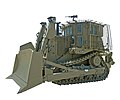Caterpillar D9
The Caterpillar D9 is a bulldozer designed and manufactured by Caterpillar . The model is produced in the East Peoria plant .
The D9 is at the top of the list with 354 kW (474 hp ) but isn't the heaviest in the range. This starts with the D3 with 57 kW (77 PS) and a weight of 8 tons and ends with the D11, which has 698 kW (935 PS) and a working weight of 104 tons.
variants
- D9X
- The D9X were near-series prototypes that were built from 1954.
- D9D
- First production version, was delivered from 1955. At that time, the Caterpillar D9 was the largest and most powerful bulldozer in the world, weighing 27,000 kg.
- D9E
- The D9E with 246 kW (335 PS) was built from 1959.
- D9G
- The newer version with a more powerful 287 kW (390 hp) diesel unit was built from 1961. Two bulldozers could be fixed together laterally in order to use an extra-wide dozer blade .
- D9H
- More powerful variant with 302 kW (410 PS) was built from 1974 to 1981.
- D9L
- Variant from 1980. Thanks to the increased built-in drive wheel, maneuverability was improved and the ground clearance was increased. It is the most powerful of all variants with 340 kW and at the same time the heaviest with around 69 t.
- D9N
- Slightly modified variant
- D9R
- Heavily modified variant with the new Cat C18 ACERT 306 kW (416 PS) diesel unit.
- D9T
- The latest variant, has been built since 2004
use
The D9 is mostly equipped as a bulldozer, although it is also available in other model variants, including a heavily armored version (D9R) to clear the battlefield of debris or to make roads and slopes passable again. It was and is used in various operations of the Israeli Armed Forces to destroy and clear already heavily damaged infrastructure ( house demolition in the Israeli-Palestinian conflict ). This was last the case in Operation Cast Lead in 2008/2009. Its long life expectancy, reliability, size and low resource cost have made the D9 one of the most popular bulldozers in the world, along with the Komatsu D275A, which is the D9's main competitor.
Use in the Israeli army
The engineer units of the Israel Defense Forces (IDF) have been using D9L, D9N and D9R, which they refer to as "bears", for decades. The area of responsibility is clearing mined areas, exposing roads, creating sand walls and salvaging broken tanks. During the terrorist attacks against Israel in the 1990s, methods were developed to operate loss-free in urban areas that were heavily mined and riddled with booby traps. The aim was to level the houses in which armed terrorists hid or in which the families of suicide bombers live. Since the terrorists often hid improvised booby traps ( IED ) with an explosive force of 200 to 500 kg in such areas, normal battle tanks proved to be unsuitable, as they are primarily armored against attacks from the front. The modifications and additional armor on the engine and cabin were carried out by IMI in cooperation with the manufacturer. A fire extinguishing system, smoke missile and, if necessary, a machine gun for self-defense can also be installed. The third generation of the D9R has been provided with gratings to be more resistant to fire from RPG-7 bazookas . The bulldozers can also be remote controlled for use against booby traps. During their missions, the bulldozers were often shot at by snipers with sniper rifles and remote-controlled anti-tank guided weapons.
Use with the USMC / US Army
The US Army was already using the D9 bulldozer during the Vietnam War to clear forest areas. This was necessary to create airfields, artillery positions and bases according to the field. From 1975 the heavy bulldozers were replaced by the lighter D7G and have been used in "US combat engineering battalions" ever since. The USMC used their D9 on missions in Iraq and Afghanistan.
IDF D9R - Military Use





